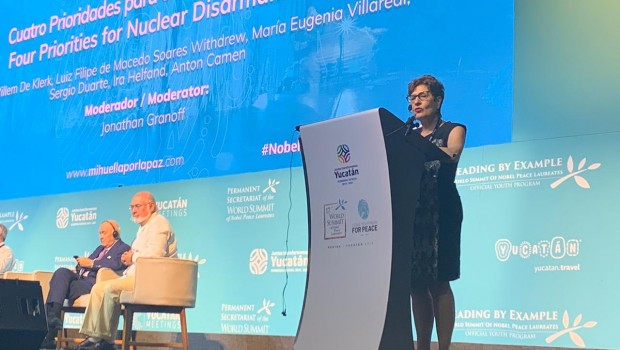Since August 1945, when the US detonated the first atomic bombs over Hiroshima and Nagasaki, the Nobel Peace Prize has been awarded eight times to individuals and organizations for their work to prevent nuclear war and to rid the world of the scourge of nuclear weapons.
Yet in 2019—almost 75 years after this dire warning that nuclear weapons threaten our very existence—nuclear-armed states are engaging in expensive and aggressive arms races unlike anything we’ve seen since the Cold War between the US and the former Soviet Union. For the past two years, the Doomsday Clock has been set at two minutes to midnight—the closest it has been during the entire nuclear age.
Just within the past several months, the US has withdrawn from the multinational agreement that prevents an Iranian nuclear weapons program; both the US and Russia have walked away from the 1987 Intermediate Nuclear Forces Treaty (INF); five Russian scientists were killed and radiation was released in an explosion during a test of a new hypersonic cruise missile designed to evade US missile defenses; the US began development of a new low-yield warhead and a nuclear-armed, sea-launched cruise missile; and North Korea has conducted several missile tests which the government has called a direct response to “double-dealing” by South Korea and the US.
Direct and indirect threats to use nuclear weapons have multiplied, even as the nuclear-armed states spend billions of dollars to make nuclear weapons that are more accurate and more usable.
As Nobel Peace Laureates, we have repeatedly warned about the catastrophic consequences of nuclear war, and we are compelled to do so again.
A large scale nuclear war between the United States and Russia, , in which thousands of warheads were detonated, would kill hundreds of millions and would produce a nuclear winter, which would kill the vast majority of the human population and which might lead to our extinction as a species.
A war in South Asia would also be a catastrophe for the entire planet. New studies, which will be published in coming weeks, show that a nuclear war between India and Pakistan could kill more than 75 million people directly and cause worldwide climate disruption dropping temperatures across the planet an average of 4o C. The resulting declines in agricultural output would trigger a famine that could put more than two billion people at risk of starvation.
We urgently call on the leaders of India and Pakistan to resolve their differences and forswear any use of nuclear weapons, and we call on the entire international community to lend its good offices to the efforts to avoid a nuclear disaster in South Asia.
Looking beyond the immediate crisis, we call on world leaders to take decisive action to eliminate the danger of nuclear war. The entry into force of the Comprehensive Test Ban Treaty, negotiated more than 20 years ago, is urgently needed. In July 2017, the United Nations adopted a landmark Treaty on the Prohibition of Nuclear Weapons by a vote of 122-1. The TPNW, in a long-overdue step, finally places the world’s worst weapons on the same legal footing as chemical and biological weapons, antipersonnel landmines and cluster munitions, declaring them illegal on the grounds of their unacceptable humanitarian consequences.
The TPNW has passed the halfway point toward the 50 ratifications needed to bring it into force. The Treaty itself is only a first step. The States Parties to the treaty must make full use of its legal, political, and moral norms to bring the nuclear-armed states into compliance, despite their current reticence. We support efforts, such as the Back from the Brink campaign in the United States, to bring about fundamental policy change in the nuclear armed state. We commend the States that have already signed and ratified the TPNW, and we urge all other states—including the nuclear-armed states—to do so as soon as possible, and to get on with the urgent task of eliminating nuclear weapons once and for all.










